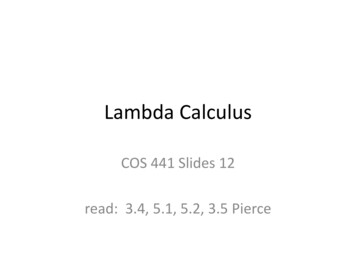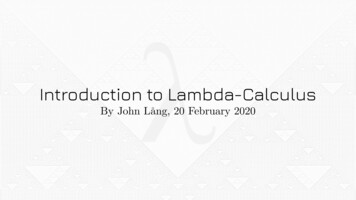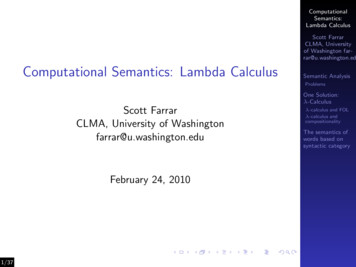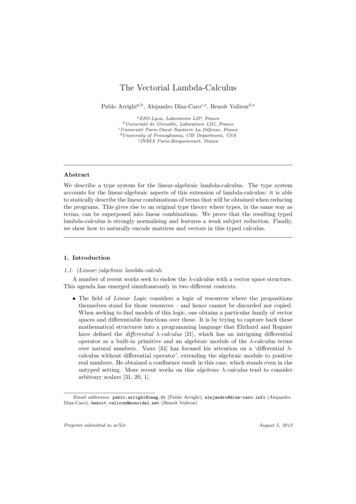
Transcription
Lambda CalculusCOS 441 Slides 12read: 3.4, 5.1, 5.2, 3.5 Pierce
the lambda calculus Originally, the lambda calculus was developed as a logic byAlonzo Church in 1932 at Princeton– Church says: “There may, indeed, be other applications of thesystem than its use as a logic.”– Dave says: “There sure are!” The lambda calculus is a language of pure functions It serves as the semantic basis for languages like Haskell thatare based around functions, but also pretty much every otherlanguage that includes some notion of function It is just as powerful as a Turing Machine (lambda terms cancompute anything a Turing Machine can) and provides analternate basis for understanding computation Pierce Text, Chap 3, 5
Operational Semantics Denotational semantics for a language provides a functionthat translates from program syntax into mathematicalobjects like sets, functions, lists or even some otherprogramming language– a denotational semantics acts like a compiler Operational semantics works by rewriting or executingprograms step-by-step– it uses only one program syntax to explain how a program runs As languages become more complicated, it is often easier todefine operational semantics than denotational semantics– it requires less math to do so– but you might not be able to prove particularly strong theoremsusing the semantics Starting with the lambda calculus, we will look at operationalsemantics
Operational Rules Operational rules typically look like this:condition1 . conditionksubprogram -- subprogram'prog -- prog' Read prog -- prog' as prog "steps to" prog' prog -- prog' is a new kind of judgement (akaproperty/assertion/claim)
Operational Rules Operational rules typically look like this:condition1 . conditionksubprogram -- subprogram'prog -- prog' Read prog -- prog' as prog "steps to" prog' prog -- prog' is a new kind of judgement (akaproperty/assertion/claim) An example, defining evaluation of if statements:e -- e'if e then c1 else c2 -- if e' then c1 else c2if True then c1 else c2 -- c1if False then c1 else c2 -- c2
LAMBDA CALCULUS
syntaxe :: x \x.e ee(a variable)(a function; in Haskell: \x - e)(function application)[ “\” will be written “ ” in a nice font and pronounced "lambda"]
syntax the identity function: \x.x 2 notational conventions: applications associate to the left (like in Haskell):“y z x” is “(y z) x”the body of a lambda extends as far as possible to the right:“\x.x \z.x z x” is “\x.(x \z.(x z x))”
terminology\x.x xthe scope of x is the entire body of the function(ie: the x’s that appear in the body of the function refer to that particular argument)\x.x yy is free in the term \x.x yx is boundin the term \x.x y
scope again, shadowed namesthe scope of theright-most x includesthe body of the function;the scope of the left-mostx does notif you wanted torefer to the first x,above, well you can’t.You should have chosena different variable namein your programs\x.\x. x x\y.\x. x yImportant note: The names of bound variables don’t matter tothe semantics of lambda calculus programs, so you can renamebound variables (provided you do so consistently) whenever you want.\x.x\x.\y.x y \y.y\y.\x.y x \z.z\z.\w. z w
Call-by-value operational semantics single-step, call-by-value operational semantics:e -- e’ In English, we say “e steps to e’” This is a new kind of “judgement”, just like a Hoare triple was ajudgement and there were rules that allowed us to concludewhen it was a valid judgement
Call-by-value operational semantics single-step, call-by-value operational semantics: e -- e’– values are v :: \x.e– primary rule (beta reduction):(\x.e) v -- e [v/x]call-by-valuesince argument is avalue rather thangeneral expression– e [v/x] is the expression in which all free occurrences of x in e arereplaced with v– this replacement operation is called substitution– implementing substitution for the lambda calculus properly isactually tougher than it would seem at first
operational semantics beta rule:(\x.e) v -- e [v/x](beta) is used together with search rules:e1 -- e1’e1 e2 -- e1’ e2(app1)e2 -- e2’v e2 -- v e2’(app2) notice, because of the rules, evaluation is left to right and that's it -- 3 rules -- that is all you need to know aboutevaluating expressions in the lambda calculus!
Example Program:(\x.e) v -- e [v/x](beta)((\x.\y. x y) (\w.w)) (\z.z) Proof that it can take a step:e1 -- e1’e1 e2 -- e1’ e2e2 -- e2’v e2 -- v e2’(app1)(app2)
Example Program:(\x.e) v -- e [v/x](beta)((\x.\y. x y) (\w.w)) (\z.z)e1 -- e1’e1 e2 -- e1’ e2 Proof that it can take a step:(beta)(\x.\y. x y) (\w.w) -- \y. (\w.w) y((\x.\y. x y) (\w.w)) (\z.z) -- (\y. (\w.w) y) (\z.z)e1e2e1’e2(app1)e2 -- e2’v e2 -- v e2’(app1)(app2)
Example Program:(\x.e) v -- e [v/x](beta)((\x.\y. x y) (\w.w)) (\z.z)e1 -- e1’e1 e2 -- e1’ e2 Proof that it can take a step:(beta)(\x.\y. x y) (\w.w) -- \y. (\w.w) y((\x.\y. x y) (\w.w)) (\z.z) -- (\y. (\w.w) y) (\z.z)(app1)e2 -- e2’v e2 -- v e2’ Proof it can take a second step:(\y. (\w.w) y) (\z.z) -- (\w.w) (\z.z)(beta) So we typically write (without explicit proofs):((\x.\y. x y) (\w.w)) (\z.z) -- (\y. (\w.w) y) (\z.z) -- (\w.w) (\z.z)(app1)(app2)
Example(\x.x x) (\y.y)
Example(\x.x x) (\y.y)-- x x [\y.y / x]
Example(\x.x x) (\y.y)-- x x [\y.y / x] (\y.y) (\y.y)
Example(\x.x x) (\y.y)-- x x [\y.y / x] (\y.y) (\y.y)-- y [\y.y / y]
Example(\x.x x) (\y.y)-- x x [\y.y / x] (\y.y) (\y.y)-- y [\y.y / y] \y.y
A Non-Example Given:(\x.e) v -- e [v/x](beta)((\x.x) (\y.y)) ((\w.w) (\z.z)) One might think that:((\x.x) (\y.y)) ((\w.w) (\z.z)) -- ((\x.x) (\y.y)) (\z.z) Since:e1 -- e1’e1 e2 -- e1’ e2e2 -- e2’v e2 -- v e2’(\w.w) (\z.z) -- (\z.z) But that would require the presence of this rule:e2 -- e2’(app3)e1 e2 -- e1 e2’(app1)(app2)
Another example(\x.x x) (\x.x x)
Another example(\x.x x) (\x.x x)-- x x [\x.x x/x]
Another example(\x.x x) (\x.x x)-- x x [\x.x x/x] (\x.x x) (\x.x x) In other words, it is simple to write non-terminatingcomputations in the lambda calculus So, what else can we do with the lambda calculus?
We can do everything The lambda calculus can be used as an “assembly language” We can show how to compile useful, high-level operationsand language features into the lambda calculus– Result adding high-level operations is convenient forprogrammers, but not a computational necessity– Result make your compiler intermediate language simpler Translations that show how to implement various usefulprogramming features in the lambda calculus are typicallycalled "Church encodings" after Alonzo Church
Aside Single-step reduction, one by one, gets pretty tedious, so wecan make up a new notation for multi-step evaluation (andgive the new notation a formal definition!) To say a program takes 0, 1 or many steps, we write:e -- * e' Rules:e -- * e(reflexivity)e1 -- e2e2 -- * e3e1 -- * e3(transitivity)
Asidee -- * e(reflexivity)e1 -- e2e2 -- * e3e1 -- * e3 A multi-step proof:a -- b b -- * ea -- * e(transitivity)
Asidee -- * e(reflexivity)e1 -- e2e2 -- * e3e1 -- * e3(transitivity) A multi-step proof:b -- c c -- * ea -- b b -- * ea -- * e
Asidee -- * e(reflexivity)e1 -- e2e2 -- * e3e1 -- * e3(transitivity) A multi-step proof:c -- db -- c c -- * ea -- b b -- * ea -- * ed -- ed -- * ee -- * e
Asidee -- * e(reflexivity)e1 -- e2e2 -- * e3e1 -- * e3(transitivity) A multi-step proof:proof thata -- bc -- db -- c c -- * ea -- b b -- * ea -- * ed -- ed -- * ee -- * e
CHURCH ENCODINGS
Let Expressions It is useful to bind intermediate results of computations tovariables:let x e1 in e2 Question: can we implement this idea in the lambda calculus?source lambda calculus lettranslate/compiletarget lambda calculus
Let Expressions It is useful to bind intermediate results of computations tovariables:let x e1 in e2 Question: can we implement this idea in the lambda calculus?translate (let x e1 in e2)
Let Expressions It is useful to bind intermediate results of computations tovariables:let x e1 in e2 Question: can we implement this idea in the lambda calculus?translate (let x e1 in e2) (\x. translate e2) (translate e1)
Let Expressions It is useful to bind intermediate results of computations tovariables:let x e1 in e2 Question: can we implement this idea in the lambda calculus?translate (let x e1 in e2) (\x. translate e2) (translate e1)translate (x) xtranslate (\x.e) \x.translate etranslate (e1 e2) (translate e1) (translate e2)
ENCODING BOOLEANS
booleans we can encode booleans– we will represent “true” and “false” as functions named“tru” and “fls”– how do we define these functions?– think about how “true” and “false” can be used– they can be used by a testing function: “test b then else” returns “then” if b is true and returns “else” if bis false the only thing the implementation of test is going to be able to dowith b is to apply it the functions “tru” and “fls” must distinguish themselves whenthey are applied
booleans the encoding:tru \t.\f. tfls \t.\f. ftest \x.\then.\else. x then else
booleanstru \t.\f. tfls \t.\f. ftest \x.\then.\else. x then elseeg:test tru a b
booleanstru \t.\f. tfls \t.\f. ftest \x.\then.\else. x then elseeg:test tru a b (\x.\then.\else. x then else) (\t.\f.t) a b
booleanstru \t.\f. tfls \t.\f. ftest \x.\then.\else. x then elseeg:test tru a b (\x.\then.\else. x then else) (\t.\f.t) a b-- * (\t.\f. t) a b
booleanstru \t.\f. tfls \t.\f. ftest \x.\then.\else. x then elseeg:test tru a b (\x.\then.\else. x then else) (\t.\f.t) a b-- * (\t.\f. t) a b-- * a
Challengetru \t.\f. tfls \t.\f. ftest \x.\then.\else. x then elsecreate a function "and" in the lambda calculus that mimicsconjunction. It should have the following properties.and tru tru -- * truand fls tru -- * flsand tru fls -- * flsand fls fls -- * fls
SUMMARY
Summary The Lambda Calculus involves just 3 things:– variables x, y, z– function definitions \x.e– function application e1 e2 Despite its simplicity, despite the apparent lack of if statementsor loops or any data structures other than functions, it is Turingcomplete Church encodings are translations that show how to encodevarious data types or linguistic features in the lambda calculus
the lambda calculus Originally, the lambda calculus was developed as a logic by Alonzo Church in 1932 at Princeton -Church says: "There may, indeed, be other applications of the system than its use as a logic." -Dave says: "There sure are!" The lambda calculus is a language of pure functions









